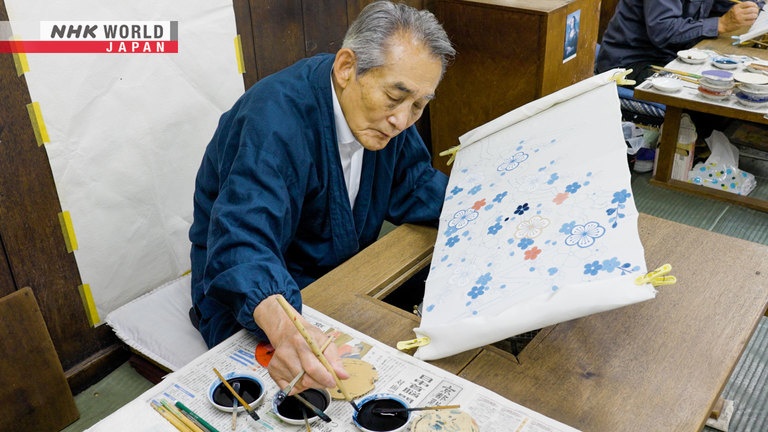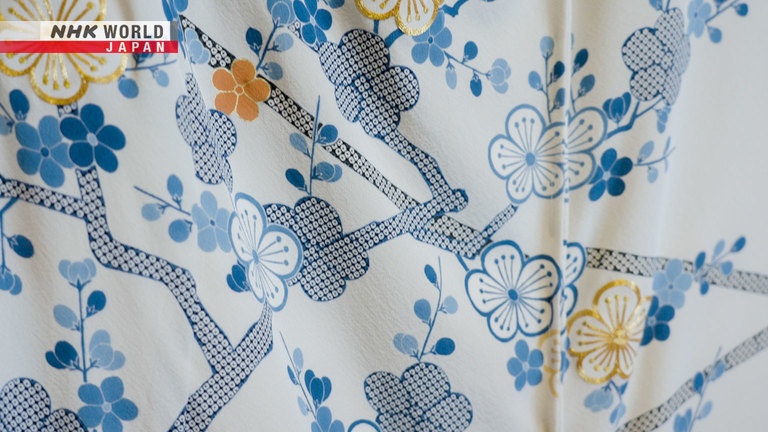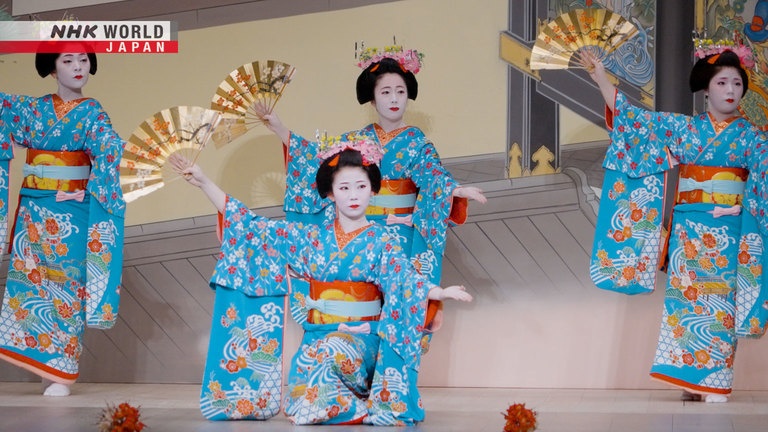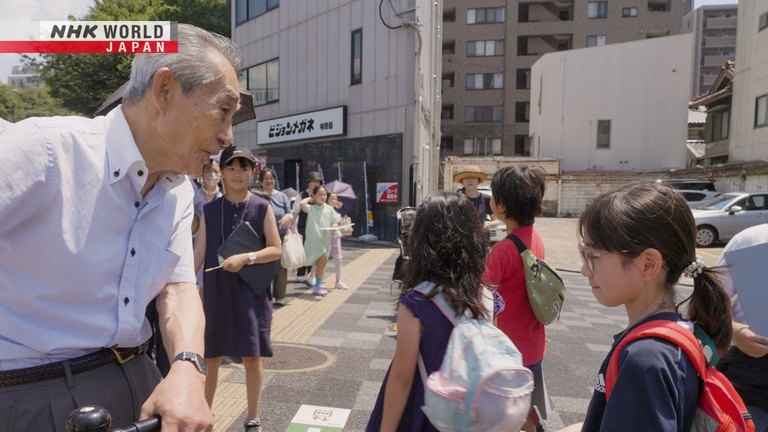Kyoto Kimono Dyer - Tabata Kihachi
Kyo-yuzen is a famous dyed textile from Kyoto Prefecture, used in kimono. The Tabata family have been top producers for decades; they've produced garments for a royal wedding, costumes for maiko in a popular dance performance and modern kimono too. The 88-year-old, 5th generation owner, Tabata Kihachi, produces dynamic, contemporary designs that preserve traditional techniques. At a solo exhibition in Tokyo, he shares his wisdom with visitors, and explains why people wearing kimono seem to glow.




Transcript
FRONTRUNNERS
In this life you're constantly learning. Right until the end.
His kimonos are almost magical.
He picks the right colors for each show. It's just such an honor.
A kimono can transform a woman. I want to create work to be proud of.
Kyoto kimono dyer
Tabata Kihachi
The Miyako Odori is a traditional feature of spring in Kyoto.
The dance performance by these young traditional entertainers, called "maiko,"
can only be enjoyed in April each year.
The matching blue kimonos worn here
bear a cherry blossom design evocative of spring.
And watching on proudly is master kimono dyer, Tabata Kihachi,
creator of garments for this show for the past half century.
The end of the performance is set in spring, with cherry blossoms.
So that blue is the ideal complement.
It was excellent.
The dances, the costumes...
The costumes are swell designs.
Very striking, very colorful.
Each year, Tabata produces a new set of costumes for the occasion
with striking new patterns on both the body and sleeves of each kimono.
Abstract motifs wouldn't do.
So I create something classical with a modern twist.
The show's director is Inoue Yachiyo.
She is officially recognized among Japan's Living National Treasures.
Good morning.
Each year, she trains and choreographs the maiko especially for the show.
And each year, she turns to Tabata to create the all-important costumes.
For many years now,
he's helped us decide how best to showcase the maiko on the stage.
Even at the age of 88, he plans it all out for us.
It's just such an honor.
The Tabata family tradition of "yuzen" hand dyeing
actually dates back five generations and over 200 years.
Each of Tabata's creations
is painstakingly decorated one brush stroke at a time,
with everything from design to coloration handled by Tabata himself.
Since taking up the family craft at the age of 35,
he's worked on countless creations.
Including this bridal kimono decorated with auspicious symbols
like drums and folding fans.
All in a palette of gold and vibrant hues.
Here, different shades of indigo are used to create a riverside scene
on this smart everyday kimono.
While this piece, for younger women,
demonstrates a playful eye through colorful seashells
against a deep black backdrop.
And here is a realistic depiction of two cranes amid pine trees.
For Tabata, the kimono is a canvas to depict myriad different worlds.
(Kyoto)
Recently, we joined Tabata Kihachi as he embarked upon a major new project.
Good morning, sensei.
Motoji Keita is the young heir to a well-known kimono merchant
in Tokyo's historic Ginza district.
He's here to discuss a special kimono for an exhibition in the summer.
The theme this year is "ripening."
You turn 88 this year.
And rice is a symbol of that age. So, I picture rice, and other crops.
All these plants yield bounty. They owe their growth to water.
What do you have in mind?
Something to do with water, with inspiration from the past.
This album contains photos of
the Tabata family's Edo-period kimono collection.
Pine, bamboo, plum, it's all here.
I'll try auspicious symbols, combined with a water theme.
Tabata decides to take his cues from this classic kimono design.
Next, Tabata delves into the collection
to unearth the actual 17th-century piece shown in the book.
A rhomboid pattern down the right side of this design evokes pine bark.
Onto that are embroidered cascading plum blossoms.
Meanwhile, the short gold lines
embroidered onto the pine bark represent bamboo nodes.
Good Japanese art prefers subtle hints over obvious depiction.
It's very Japanese how only the plum is shown clearly,
with just hints at pine and bamboo.
The key thing I'm aiming for is this.
The classical designs are an important reference,
but I want to create something new and wonderful.
Spring 2023 saw a gala reception in honor of Tabata's 88th year.
The event drew kimono enthusiasts from all over Japan.
Good health!
Many attendees wore their own favorite Tabata designs.
In an age where kimonos are dwindling in popularity,
the Tabata name remains a strong selling point.
I like to wear this for celebratory occasions like today.
They've been using the same indigo dyes for centuries
and Tabata-sensei always says it's their family treasure.
This mother and daughter have also come in Tabata creations.
They evolve to suit you as you age.
When I was younger, the power of the kimono helped me to shine.
And as you age, they change with you.
His kimonos are almost magical.
I've worn this kimono since my 20s, so over 50 years now.
Her mother was a fan, too.
I wear them, and now my daughter does too.
Three generations, which is amazing.
With modern clothes, you'd be different sizes, but kimonos solve that.
That's what's fantastic about them.
I'm so happy to see everybody wearing these garments
that I put so much effort and energy into. Very happy.
It's now a month on from Tabata's meeting
about the new design for Motoji Keita.
They all integrate a wave motif.
Something like this might work.
They're here today to choose the final design.
This looks great already.
OK. I'll brush this one up as I go.
Here is Tabata's final design sketch.
The right-hand side depicts a dynamic cascade of water,
while the left displays the classic elements of bamboo, pine, and plum.
The next step is to recreate this design on a full-sized kimono.
These outlines can be washed out once the final color is added.
And for Tabata,
a particular focus here will be the swirling patterns of the water.
What can you say about water?
It's the most frightening thing there is, and the most important.
In the heat, it's a vapor.
In the cold, it's a solid. Ice.
It's capricious, unknowable.
Water's my biggest inspiration.
I worship it. And it features in most of my designs.
Hi there. Follow me.
With the basic design outline done,
where is Tabata heading with the kimono?
Komai-san does my resist lines.
Hi there.
Oh my back hurts.
We have to block these bits off, right?
That's right.
Got it.
"Resist paste" outlines are a vital step in preparing the fabric for dyeing.
Komai Tatsuo is a 40-year veteran of this craft.
He uses a selection of special pipettes
to match the size of individual lines in the design.
And this rice-based paste will prevent unwanted color seepage.
Over the years, Komai has worked on hundreds of items for Tabata.
Painstakingly going over each and every fine detail.
He uses bold strokes that evoke a torrent of water.
I have to showcase that.
Try not to lose that intensity.
It calls for great care.
We've worked many years together, so I usually know what he wants.
At 12 o'clock each day, Tabata's workshop pauses for lunch.
And every day, Tabata eats with his assistants.
But though the fifth-generation heir to this family heritage
turns 88 this year,
he's yet to find a successor of his own.
Though Tabata does have a son, he chose not to enter the family craft.
His original plan was to take this up after college,
but in the end, he wasn't into it.
He said this work had no future. That he wouldn't do it.
And I was too tough on him.
He gave all sorts of reasons just to give it up.
My own father never told me what to do.
I'm moody, so if he'd told me to do this, I'd probably have refused.
He just left it to me.
And eventually, I realized this work was my duty as the eldest male heir.
I chose my schools and so on based on that.
You can't do this work without self-motivation.
Realizing he might be the end of the line,
Tabata launched a new initiative.
We find a small group gathered in front of his workshop.
These children are from a Kyoto elementary school.
What we do here is called Kyo Yuzen. It's a kind of yuzen dyeing.
See that kimono hanging up there? That one took me about six months.
These workshops are a collaboration with a Kyoto-based NPO.
The idea is to introduce children to the world of yuzen dyeing.
We press liquid from flowers and imbue cotton with that.
Then we dissolve that in water for use.
Children even get to see an original design sketchbook
used by the head of the family line two whole centuries ago.
Look at this. All drawn with a brush.
Wow!
It's very detailed. These are his designs. Can you see?
All done with a brush.
Wow, look at that!
Next, Tabata takes them to see another local workshop.
How old are you?
Me? I'm 88. Why?
You seem much younger.
I'm 88.
I thought you were 70!
Nope, I'm 88!
I thought you were, like, 75!
Seventy-five? That's pretty specific!
This is where sheets of kimono fabric are dyed.
Long strips of resist-pasted fabric
are stretched out and dyed with large brushes.
You go top, middle, bottom.
And you need to be sure to maintain a consistent number of strokes.
Tabata tries to show the children all aspects of traditional Kyo Yuzen dyeing.
Do they work between these?
Both sides must be the same hue.
Don't get too close!
It was fun to learn so much about traditional culture.
I'd never seen these tasks before, so that was fun to see.
Now I'd like to make one too.
You look cool in your sunglasses.
Pardon?
You look cool in your sunglasses.
What?! You said I looked 70!
I'm 88.
How old are you?
I'm nine.
Nine! Just 80 years apart, then!
They listen very eagerly.
Of course, taking an interest doesn't mean these kids will take up the craft,
but it's important to let them learn about it, because that stays with you.
I was always here back in first, second grade and it stuck with me.
That's how it works.
These are our color charts.
Tabata's piece for the exhibition in Ginza is almost ready to color.
He selects shades from the time-worn family color charts.
When discussing colors for, say, the Miyako Odori,
you need these concrete reference points.
Like it says here, "This is the color we used in 2009."
You need to preserve all those.
Of course there are endless colors, even just with indigo,
so I have to be able to show the colors I see in my head.
You can't just verbally explain a color to somebody else.
People can't "hear" a color.
That's why you need these, to show them what you mean.
We join Tabata on a research trip to downtown Kyoto.
For some further color inspiration,
he heads to the makeup section of a large department store.
But what is he here to see?
Is this all the lipstick you have?
Yes, that's right.
How many colors are there?
Lots. We have around 100.
Each year, the selection changes.
Tabata asks the salesperson about current color trends.
Do the tastes of young and old differ?
Yes. Young people like glossier colors.
Oh really?
In terms of a woman's kimono or other outfit,
it's your lipstick color that tops things off.
It's as important as the cherry on the cake.
I came to ask about that.
Back at his workshop,
Tabata has started to color the kimono for the exhibition in Ginza.
This is the step that breathes life into yuzen garments.
The fabric is warmed from underneath to speed up the drying process.
I use this little charcoal burner.
And he insists upon the use of bamboo charcoal.
Other people use electric, but think.
A charcoal grill makes chicken or fish taste
better than an electric one does.
Same logic.
The Tabata specialty is leveraging different shades of indigo.
So much so that it gave rise to the term "Tabata Blue."
All women are different, but none of them ever dislike indigo.
You have to decide which colors work where and how.
That's very important.
Two months later, the completed piece arrives in Tokyo for the exhibition.
Tabata Kihachi-san's kimono is here.
Let's open it up.
Oh wow. Fantastic.
Amazing. Look at the fine embroidery.
The final piece is entitled "Nami ni Shochikubai."
Edo-period styling reborn for the modern age.
The lower left depicts plum blossoms,
embroidered in vibrant coral red and gold
on a subtly shifting indigo backdrop.
Down the right-hand-side is a bold and dynamic wave motif.
Overall, it has a refined understatement.
For the exhibition opening, Tabata makes the trip to Tokyo in person.
And he's welcomed by throngs of dedicated fans.
This style is known as Kambun Kosode.
He gives a talk on the new kimono
and the Edo-period piece that inspired it.
Viewed from the front or the rear, it gives a very different impression.
I recreated it in semi-formal form.
Some lucky attendees even get to try on Tabata's new creation.
At last, we can appreciate its full dazzling appeal.
The frontal view showcases the plum blossom motif...
while the rear carries the swirling wave design.
The colors are lovely.
There's a lot of detail, but it's not overbearing.
It has a dynamism that is very contemporary,
but it also has that classical feel.
It's fantastic.
- It looks totally different when worn.
- Doesn't it!
Well of course! It's a kimono, so it has to be worn!
I wasn't sure it would suit me, but now I have it on...
Totally different, right?
I love it.
So what is master kimono dyer Tabata Kihachi's motivation
as a "frontrunner" in his field?
You really have to take pride in giving your all.
You can't just say, "This will do."
You have to keep going.
It's all just another stop along the way.
You have to put your soul into everything you do, every last bit.
And that's the same for any job, your job too.
Put your soul into it.